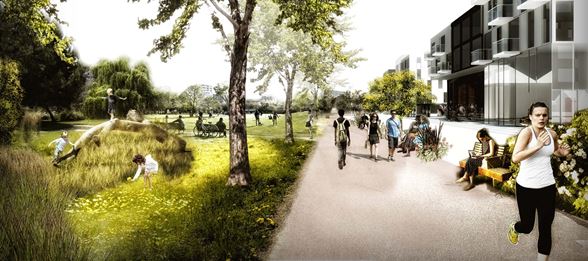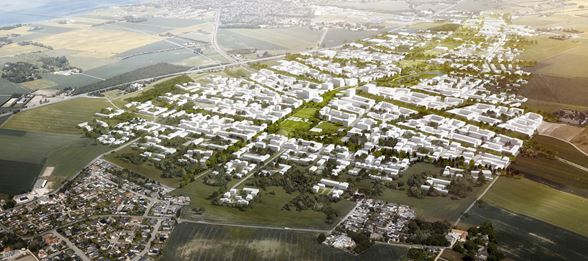
Henning-Larsen Architects, a leading Danish design firm, is currently designing Denmark’s largest urban development project to date, Vinge City. Located north of Copenhagen, this city will cover 370 hectares and will be a space for the notions of sustainability, diversity, and connection to converge.
The region recognized the need for a new urban development after analyzing the statistics of residents in the area – nearly 1,000 new residents move to Copenhagen each month. Thus, there is an immediate and growing demand for housing.
Copenhagen is already a green design hub – the city was voted the “European Green Capital” by the European Commission in 2014. The number of bikes in the city has just surpassed the number of cars. Vinge will just be another addition to a city that already excels in urban planning, energy conservation, and landscape design. Sustainable infrastructure is even easier to incorporate into a new city like Vinge, which is being built from the ground up. State-of-the-art technologies will be incorporated into the city as they are developed. For example, the city plans to include service stations for electric cars, paths for pedestrians and bikers, and rainwater-collecting ponds. Furthermore, the city will lower energy costs and needs by strategically incorporating daylight into the architecture.
The urban development project stemmed from the idea of a centralized train station. While many urban development projects begin with a powerful skyscraper or a section of residential spaces, the idea to start with a train station highlights the focus of this city. Vinge will emphasize connectivity – the train station not only links citizens to other cities in Denmark, but it easily connects the residents to urban and natural spaces in their own town.
The design of the train station itself seamlessly fits with the architects’ core objective to craft a sustainable city that blends and blurs the meanings of “urban” and “natural.” The station is shaped like a bowl and looks as if it sinks into the ground, blending with the pre-existing, natural terrain. In an interview, Railroad Technology stated that, “Its form follows the natural landscape, working congruously with its surroundings.” A large bridge will also make up a large part of the station design, connecting the space with its natural surroundings, rather than sectioning it off like the designs of many train stations tend to do. This design results in an integrated city – there is no “good” or “bad” side. Neither side is exposed to environmental issues like excess pollution or limited green spaces. Using their hallmark environmental design strategies, Henning-Larsen’s concrete station will also collect rainwater in gutters to be reused.

The station is the heart of the city and the living and working spaces extend out from it. Homes, shops, and offices will occupy the spaces closest to the train station, encouraging residents to rely on public transportation rather than driving. The city is a mere thirty minute train ride from Copenhagen. The architects claim that the accessibility of public transportation will make the city more attractive to businesses, encouraging them to establish office spaces in the city center.
Vinge is located in an open, rural setting and one of Henning- Larsen’s leading goals was to integrate the surrounding greenery into the defined, urban space. The architects say that, “Green areas within the urban context create breathing spaces, add a recreational dimension to the city — such as playing fields, urban parks and wetlands — and ensure nature’s enduring presence in the city.” The center of the city is characterized by the “Green Zone,” a stretch of land that will house gardens, city parks, natural wetlands, water-collecting ponds, and recreational areas. This “Green Zone” also makes time spent at the station more enjoyable; if you miss a train, rather than being trapped in an underground concrete jungle, you are exposed to natural wetlands and tree- filled parks. Flemming Thomsen, an architect who collaborated on the project, stated that, “We wanted a unified, dynamic space with a very present feeling of nature. If we look at people’s requirements for a good life, a lot of that’s tied to nature. When you’re stopping at the station, you should be equally connected to the natural and urban setting.”
Another cornerstone of the project is diversity. Housing around 10,000 and employing around 4,000, the city will be open to everyone. There are a variety of buildings, offering a variety of residential typologies to meet the needs of all sorts of families and residents. The architects believe that, “Vinge will be a city for families, the young and the elderly, companies, and visitors.”
While Denmark has been at the forefront of environmental design since its earliest days, the concept is beginning to permeate the design world in the U.S. In an interview with LMS Architects, a San Francisco environmental design firm, Richard Stacy, partner of the firm, mentioned that San Francisco is beginning to develop a greater commitment to sustainable design – currently, all buildings in the Transbay neighborhood are required to install purple pipes, a future water reuse system.





